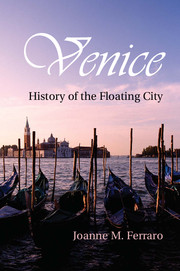Book contents
- Frontmatter
- Contents
- Plates
- Illustrations
- Maps
- Acknowledgments
- Preface
- Chronology of Historical Events
- 1 Reconstructing the Floating City
- 2 The Riches of Asia, Europe, and North Africa
- 3 A Pride of Lions
- 4 Identities and Modes of Socialization
- 5 Material Life
- 6 City of Myth
- 7 The Serenissima’s Wayward Subjects
- 8 The Baroque Stage
- 9 Epilogue
- Appendix I Approximate Population of Venice during the Republic
- Appendix II Population of the Historic Center of Venice, 1871–2010
- Glossary
- Notes
- Bibliography
- Index
- Plate Section
Preface
Published online by Cambridge University Press: 05 August 2012
- Frontmatter
- Contents
- Plates
- Illustrations
- Maps
- Acknowledgments
- Preface
- Chronology of Historical Events
- 1 Reconstructing the Floating City
- 2 The Riches of Asia, Europe, and North Africa
- 3 A Pride of Lions
- 4 Identities and Modes of Socialization
- 5 Material Life
- 6 City of Myth
- 7 The Serenissima’s Wayward Subjects
- 8 The Baroque Stage
- 9 Epilogue
- Appendix I Approximate Population of Venice during the Republic
- Appendix II Population of the Historic Center of Venice, 1871–2010
- Glossary
- Notes
- Bibliography
- Index
- Plate Section
Summary
Preface
The only way to care for Venice as she deserves it is to give her a chance to touch you often – to linger and remain and return.
Henry JamesPerhaps no city in the world holds the allure of Venice, with its endless maze of narrow alleys and waterways. An obligatory stop on the Grand Tour, the love of John Ruskin, Henry James, Mary McCarthy, and other celebrated writers, droves of artists, scholars, and tourists continue to explore its calli and campi year after year. The floating city brings sighs of utter astonishment as sky and sea paint the landscape, changing the palette in rhythm with breaking light. Domes, rooftops, and towers glint and glaze in the summer, retreating mysteriously like ghostlike forms during the dark and misty winter. All the while the water mirrors the atmosphere, yielding tantalizing glimpses of Byzantine, Islamic, and Gothic styles.
Over the ages, Venice has been a beacon of hope for many: to the original island settlers, it augured refuge; to Crusading adventurers, it was a pilgrim stop and a place to book passage to the Holy Land; to laborers, it promised employment opportunities; to pleasure seekers, it offered spectacle, gambling, and sexual experimentation; to gentlemen on the Grand Tour, it was a finishing school to study the Venetian constitution, view monumental art, and savor Baroque music; to expatriates, it provided new ways of life; to scholars, it became a place to preserve or reinterpret the past; to artists, writers, and composers, it offered a source of inspiration and a place to seek solace and consolation. Now the floating labyrinth is one of the most visited cities in the world, luring tourists with its artistic patrimony, film festivals, Carnival celebrations, and avant-garde art expositions.
- Type
- Chapter
- Information
- VeniceHistory of the Floating City, pp. xvii - xxiiPublisher: Cambridge University PressPrint publication year: 2012

